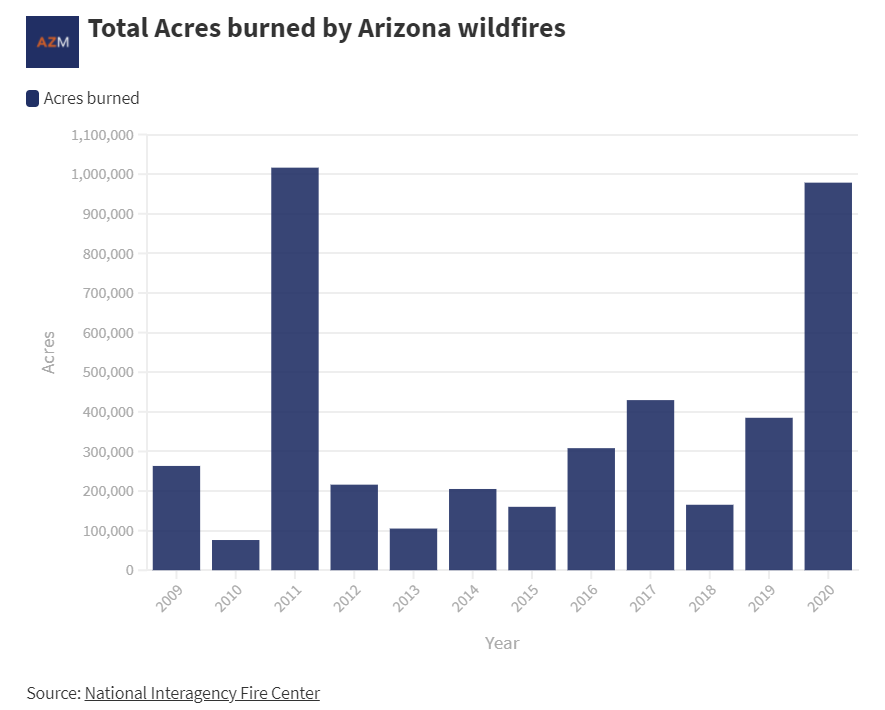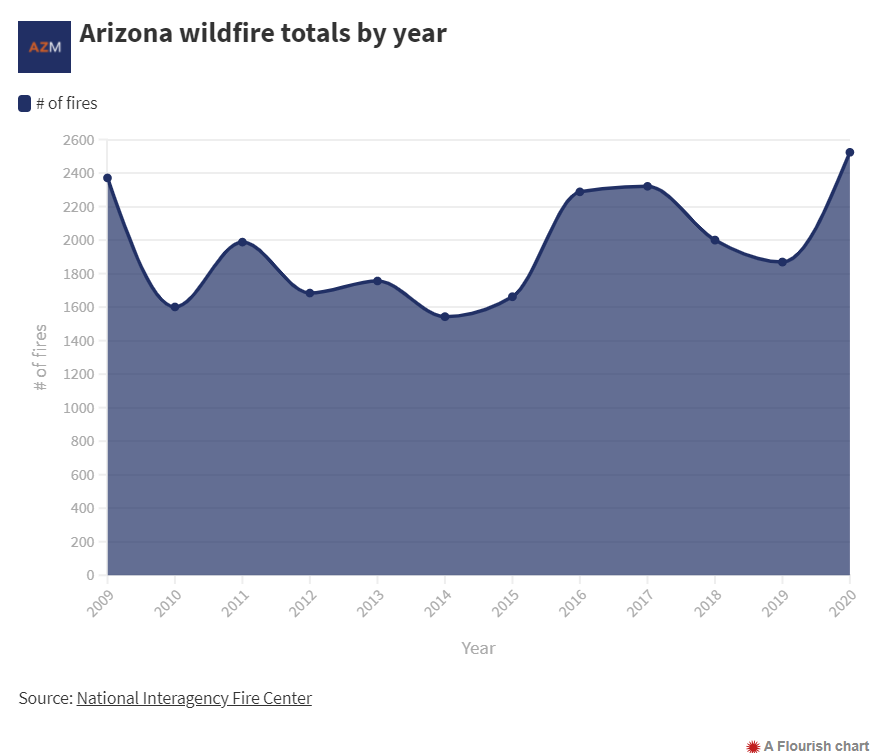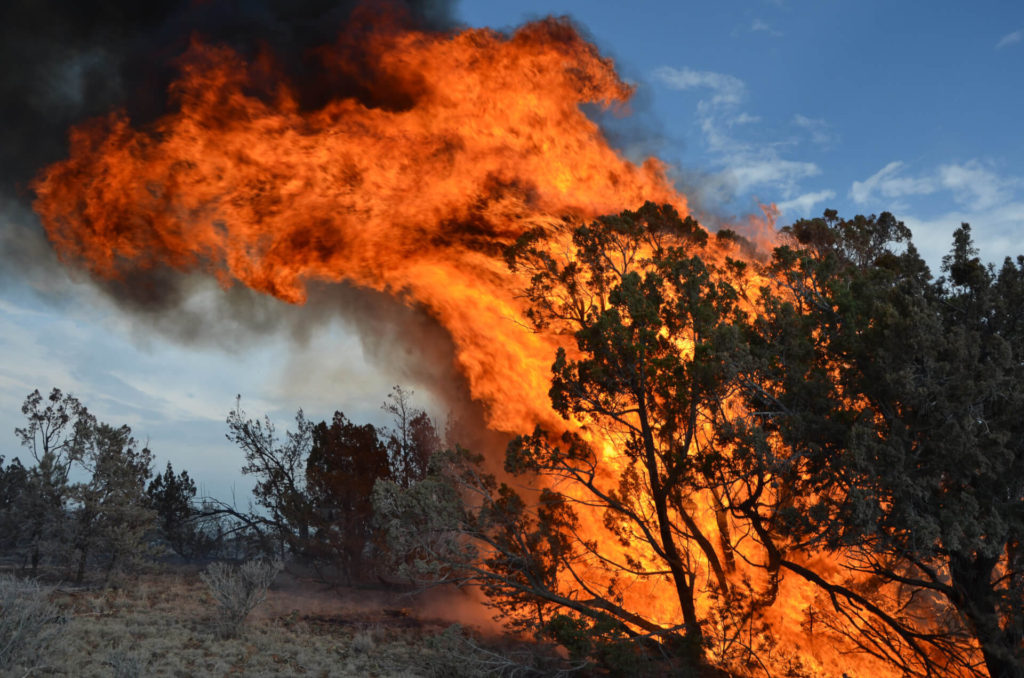There are two dozen wildfires raging across Arizona that have burned more than 366,000 acres so far, putting this year’s wildfire season on a similar trajectory to the past two years — a trend that experts worry is likely only to get worse as the effects of climate change become more acute.
“You can’t put a Band-Aid on this problem,” said Don Falk, a professor in the school of natural resources at University of Arizona whose work has focused on fires, their history and how they work. “There is no simple fix until you get serious about climate change.”
Data from the National Interagency Fire Center shows that Arizona faced its harshest wildfire season in nearly a decade in 2020, with nearly a million acres of land being burned. The only other year that comes close is 2011, when Arizona faced its largest wildfire ever, the Wallow Fire, which burned over 500,000 acres.
“You have to get serious about the underlying cause, which is the changing climate,” Falk said about how to address the growing concern of larger and hotter wildfires.
Currently, Arizona is facing two large wildfires that have been causing evacuations.
The Telegraph Fire is one of the largest wildfires in Arizona’s history, having burned more than 193,000 acres — more than the entirety of what was burned in the 2010, 2013, 2015 and 2018 wildfire seasons.
Multiple rural communities were evacuated during the fire, which is now nearing containment.

“This is actually not an unusual situation to see happening in June, but we have been having tremendous fires all year,” Dr. Erinanne Saffell, Arizona’s assistant state climatologist, said.
In Arizona, the wildfire season begins in early May, with fires typically peaking in mid- to late June, when the monsoons begin and the fires begin to drop off.
But that has been changing in recent years, Falk said.
“We’ve had fires in grasslands in southern Arizona in January and February,” Falk said, adding that drier winters, an effect of climate change, is creating the conditions for these types of fires. Additionally, monsoons are becoming more erratic — in 2020, Arizona saw its driest monsoon season ever — and changes to the La Nina weather pattern have also affected winter rains.
But how exactly does climate change cause more fires?
“Large fires are carried almost entirely by fine fuels,” Falk said. Fine fuels are things like leaves, pine cones, small branches and smaller trees. “It is important to recognize that those are the fuels that carry a wildfire.”

Those fine fuels are created by heavy wet seasons, as they allow for rapid growth. But if that wet season is followed by a dry hot season, then it creates the conditions for large fires, Falk said.
In 2020, not only was the monsoon season the driest on record, but the state set a record for the number of days with temperatures of 110 degrees or hotter, drying up much of the fine fuel.
Saffell said the state gets on average about 10 monsoon thunderstorms, but there’s no way to know whether any particular monsoon season will be wet or dry until it starts.
Those storms are instrumental in both preventing wildfires from growing and preventing worse outcomes post-fire. When soil is wet, it helps keep fires from spreading as fast, as the moisture in the soil means it takes longer to heat up. The same goes for the fuel, Falk said.
“Anybody who has tried to start a campfire with damp logs knows what I’m talking about,” he said.
Soil damaged by wildfires is a big problem, too.
“They burn the soil and harden the soil,” Saffell said. And if it rains on that hardened soil of a burn scar, the soil will run off and can create mudslides or flash floods.
Gila County, which was hit hardest by the Telegraph Fire and has been the site of many other wildfires in recent years, is constantly plagued by flash floods. Last year, a special education teacher from Miami was killed in a flash flood north of Globe.
“What climate change is doing is making the fire season longer,” Falk said. “So, your peak conditions during the fire season are again more intense, and this is absolutely a climate change influence.”
Saffell, however, disagrees — and said the conditions leading to our record-setting wildfire seasons are not new.
“For Arizona, we are not seeing that connection, that magic thing that identifies that relationship,” Saffell said. “For Arizona, we are seeing something that we have seen before.”
Saffell said that the wildfires are a natural part of the ecosystem, adding that the drier conditions have led to fuel that is more readily available to burn.
“Hopefully, we’ll get the thunderstorms and put those to rest,” Saffell said. ““We are not seeing any trends right now saying we are going to be continuously dry.”
Arizona is currently in the midst of a drought, and the period of April to March of this year was the driest on record in the last 126 years for the state.
Falk doesn’t feel the same way.
“Let’s not mess around and deny anymore and look the problem square in the face,” Falk said about climate change and its impact on wildfires. “Ten years ago I might not have said that so bluntly.”
Article Credit: azmirror
